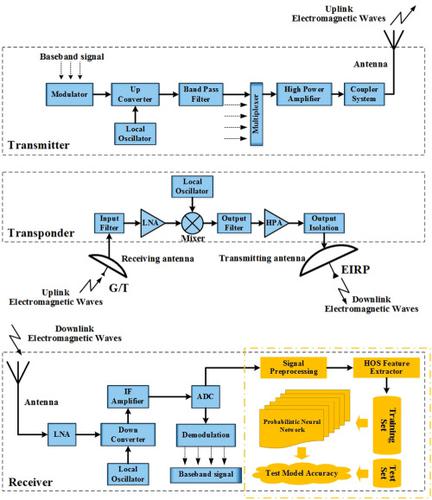当前位置:
X-MOL 学术
›
Int. J. Satell. Commun. Netw.
›
论文详情
Our official English website, www.x-mol.net, welcomes your
feedback! (Note: you will need to create a separate account there.)
Target recognition for satellite communication by employing higher‐order statistics
International Journal of Satellite Communications and Networking ( IF 0.9 ) Pub Date : 2020-08-17 , DOI: 10.1002/sat.1369 Xiaopo Wu 1 , Nian Fang 2 , Yangming Shi 3 , Yifeng Fu 4 , Kai Xie 5
International Journal of Satellite Communications and Networking ( IF 0.9 ) Pub Date : 2020-08-17 , DOI: 10.1002/sat.1369 Xiaopo Wu 1 , Nian Fang 2 , Yangming Shi 3 , Yifeng Fu 4 , Kai Xie 5
Affiliation

|
The target recognition for satellite communication (satcom) is generally regarded as the cutting edge of electronic countermeasure research. This work is dedicated to the investigation on the theory and experiment of satellite communication target recognition on the basis of systematical analysis of satcom signal emission, propagation, and reception. The authors elaborate on the fingerprint analysis, feature extraction, and identification of satcom emitters by utilizing the nonlinearities of high‐power microwave vacuum amplifier (HPA). The mechanism of the external subtle features of satcom signal will be also discussed in detail. To acquire the qualified features that precisely represent the individual emitter, higher‐order statistics technique is introduced to implement the feature extraction, and the supervised probabilistic neural network classifier is established to execute the recognition of testing satcom samples. In testing phase, there are a total of 4000 sampling signals with BPSK modulation and variable carrier to noise ratio (CNR) originated by eight types of satcom transmitters setting for the experiment to verify the authors' viewpoints. Thanks to the fine training data set and subsequent well‐extracted features, the PNN classifier had not fail us and finally achieved satisfactory accuracy of more than 94% at CNR level of 10 dB. Those expected results will help to enhance the ability of battlefield surveillance and situational awareness that is of paramount importance in academic research and military application.
中文翻译:

利用高阶统计量进行卫星通信的目标识别
卫星通信(satcom)的目标识别通常被视为电子对策研究的前沿。这项工作致力于在对卫星通信信号发射,传播和接收进行系统分析的基础上,对卫星通信目标识别的理论和实验进行研究。作者利用高功率微波真空放大器(HPA)的非线性特性,详细介绍了卫星通信发射器的指纹分析,特征提取和识别。卫星通信信号的外部微妙特征的机制也将详细讨论。为了获得精确表示单个发射器的合格特征,引入了高阶统计技术来实现特征提取,建立监督概率神经网络分类器,对测试卫星样本进行识别。在测试阶段,总共有4000种具有BPSK调制和可变载噪比(CNR)的采样信号,由八种卫星通信发射器设置产生,用于实验以验证作者的观点。得益于完善的训练数据集和随后的良好提取的功能,PNN分类器并没有使我们失败,最终在10 dB的CNR级别上获得了超过94%的令人满意的精度。这些预期结果将有助于增强战场监视和态势感知的能力,这在学术研究和军事应用中至关重要。总共有4000种具有BPSK调制和可变载噪比(CNR)的采样信号,由八种卫星通信发射器设置产生,用于实验以验证作者的观点。得益于完善的训练数据集和随后的良好提取的功能,PNN分类器并没有使我们失败,最终在10 dB的CNR级别上获得了超过94%的令人满意的精度。这些预期结果将有助于增强战场监视和态势感知的能力,这在学术研究和军事应用中至关重要。实验共有八种类型的卫星通信发射机设置,总共有4000个具有BPSK调制和可变载波噪声比(CNR)的采样信号,用于验证作者的观点。得益于完善的训练数据集和随后的良好提取的功能,PNN分类器并没有使我们失败,最终在10 dB的CNR级别上获得了超过94%的令人满意的精度。这些预期结果将有助于增强战场监视和态势感知的能力,这在学术研究和军事应用中至关重要。得益于完善的训练数据集和随后的良好提取的功能,PNN分类器并没有使我们失败,最终在10 dB的CNR级别上获得了超过94%的令人满意的精度。这些预期结果将有助于增强战场监视和态势感知的能力,这在学术研究和军事应用中至关重要。得益于完善的训练数据集和后续良好的提取功能,PNN分类器并没有使我们失望,最终在10 dB的CNR级别上获得了超过94%的令人满意的精度。这些预期结果将有助于增强战场监视和态势感知的能力,这在学术研究和军事应用中至关重要。
更新日期:2020-08-17
中文翻译:

利用高阶统计量进行卫星通信的目标识别
卫星通信(satcom)的目标识别通常被视为电子对策研究的前沿。这项工作致力于在对卫星通信信号发射,传播和接收进行系统分析的基础上,对卫星通信目标识别的理论和实验进行研究。作者利用高功率微波真空放大器(HPA)的非线性特性,详细介绍了卫星通信发射器的指纹分析,特征提取和识别。卫星通信信号的外部微妙特征的机制也将详细讨论。为了获得精确表示单个发射器的合格特征,引入了高阶统计技术来实现特征提取,建立监督概率神经网络分类器,对测试卫星样本进行识别。在测试阶段,总共有4000种具有BPSK调制和可变载噪比(CNR)的采样信号,由八种卫星通信发射器设置产生,用于实验以验证作者的观点。得益于完善的训练数据集和随后的良好提取的功能,PNN分类器并没有使我们失败,最终在10 dB的CNR级别上获得了超过94%的令人满意的精度。这些预期结果将有助于增强战场监视和态势感知的能力,这在学术研究和军事应用中至关重要。总共有4000种具有BPSK调制和可变载噪比(CNR)的采样信号,由八种卫星通信发射器设置产生,用于实验以验证作者的观点。得益于完善的训练数据集和随后的良好提取的功能,PNN分类器并没有使我们失败,最终在10 dB的CNR级别上获得了超过94%的令人满意的精度。这些预期结果将有助于增强战场监视和态势感知的能力,这在学术研究和军事应用中至关重要。实验共有八种类型的卫星通信发射机设置,总共有4000个具有BPSK调制和可变载波噪声比(CNR)的采样信号,用于验证作者的观点。得益于完善的训练数据集和随后的良好提取的功能,PNN分类器并没有使我们失败,最终在10 dB的CNR级别上获得了超过94%的令人满意的精度。这些预期结果将有助于增强战场监视和态势感知的能力,这在学术研究和军事应用中至关重要。得益于完善的训练数据集和随后的良好提取的功能,PNN分类器并没有使我们失败,最终在10 dB的CNR级别上获得了超过94%的令人满意的精度。这些预期结果将有助于增强战场监视和态势感知的能力,这在学术研究和军事应用中至关重要。得益于完善的训练数据集和后续良好的提取功能,PNN分类器并没有使我们失望,最终在10 dB的CNR级别上获得了超过94%的令人满意的精度。这些预期结果将有助于增强战场监视和态势感知的能力,这在学术研究和军事应用中至关重要。











































 京公网安备 11010802027423号
京公网安备 11010802027423号